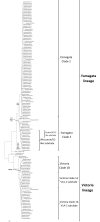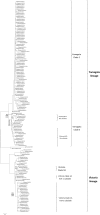Epidemiological, Clinical and Virological Characteristics of Influenza B Virus from Patients at the Hospital Tertiary Care Units in Bangkok during 2011-2014
- PMID: 27387488
- PMCID: PMC4936745
- DOI: 10.1371/journal.pone.0158244
Epidemiological, Clinical and Virological Characteristics of Influenza B Virus from Patients at the Hospital Tertiary Care Units in Bangkok during 2011-2014
Abstract
Influenza B virus, which causes acute respiratory infections, has increased in prevalence in recent years. Based on the nucleotide sequence of the hemagglutinin (HA) gene, influenza B virus can be divided into two lineages, Victoria and Yamagata, that co-circulate during the influenza season. However, analysis of the potential association between the clinical and virological characteristic and the lineage of influenza B viruses isolated in Thailand was lacking. To investigate influenza B virus genetically and determine its neuraminidase (NA) inhibitor susceptibility phenotype, a total of 6920 nasopharyngeal-wash samples were collected from patients with influenza-like illness between the years 2011 and 2014 and were screened for influenza B virus by real-time PCR. Of these samples, 3.1% (216/6920) were confirmed to contain influenza B viruses, and 110 of these influenza viruses were randomly selected for nucleotide sequence analysis of the HA and NA genes. Phylogenetic analysis of the HA sequences showed clustering into various clades: Yamagata clade 3 (11/110, 10%), Yamagata clade 2 (71/110, 64.5%), and Victoria clade 1 (28/110, 25.5%). The analysis of clinical characteristic demonstrated that the Victoria lineage was significantly associated with the duration of hospitalization, number of deceased cases, pneumonia, secondary bacterial infection and underlying disease. When combined with phylogenetic analysis of the NA sequences, four samples showed viruses with reassortant sequences between the Victoria and Yamagata lineages. Statistical analysis of the clinical outcomes and demographic data for the reassortant strains did not differ from those of the other strains in circulation. Oseltamivir-resistant influenza B viruses were not detected. Our findings indicated the co-circulation of the Victoria and Yamagata lineages over the past four cold seasons in Bangkok. We also demonstrated differences in the clinical symptoms between these lineages.
Conflict of interest statement
Figures





References
-
- Kinnunen L, Ikonen N, Pöyry T, Pyhälä R. Evolution of influenza B/Victoria/2/87-like viruses: occurrence of a genetically conserved virus under conditions of low epidemic activity. J Gen Virol. 1992;73(Pt 3):733–736. - PubMed
-
- Yamashita M, Krystal M, Fitch WM, Palese P. Influenza B virus evolution: co-circulating lineages and comparison of evolutionary pattern with those of influenza A and C viruses. Virology 1988;163(1):112–122. - PubMed
-
- Nerome R, Hiromoto Y, Sugita S, Tanabe N, Ishida M, Matsumoto M, et al. Evolutionary characteristics of influenza B virus since its first isolation in 1940: dynamic circulation of deletion and insertion mechanism. Arch. Virol. 1998;143:1569–1583. - PubMed
-
- Rota PA, Wallis TR, Harmon MW, Rota JS, Kendal AP, Nerome K. Cocirculation of two distinct evolutionary lineages of influenza type B virus since 1983. Virology 1990;175:59–68. - PubMed
MeSH terms
Substances
Grants and funding
LinkOut - more resources
Full Text Sources
Other Literature Sources
Medical
Miscellaneous

